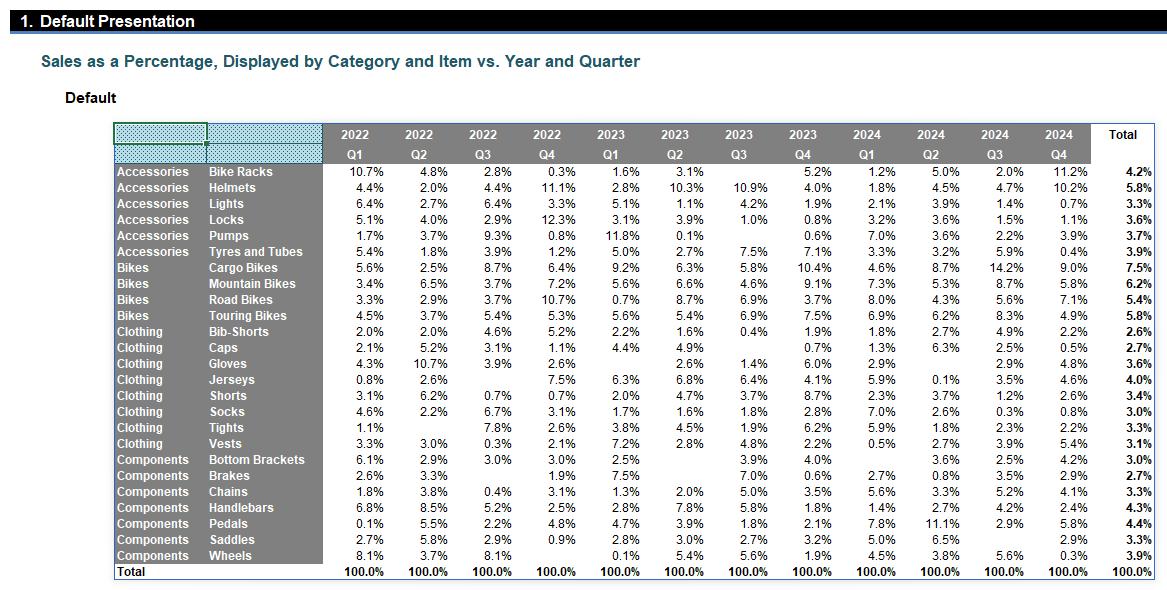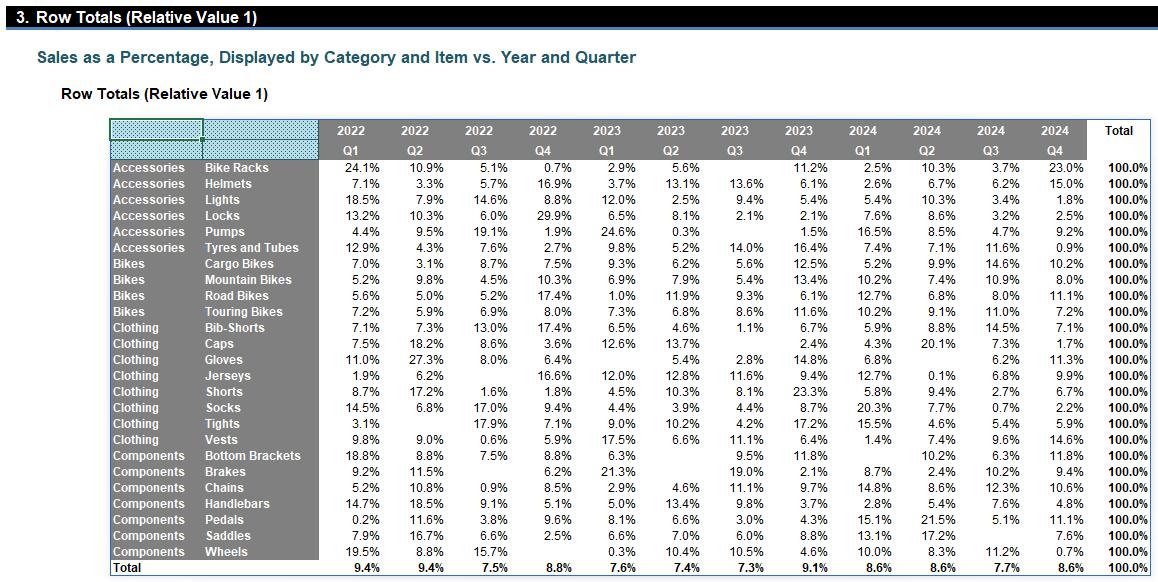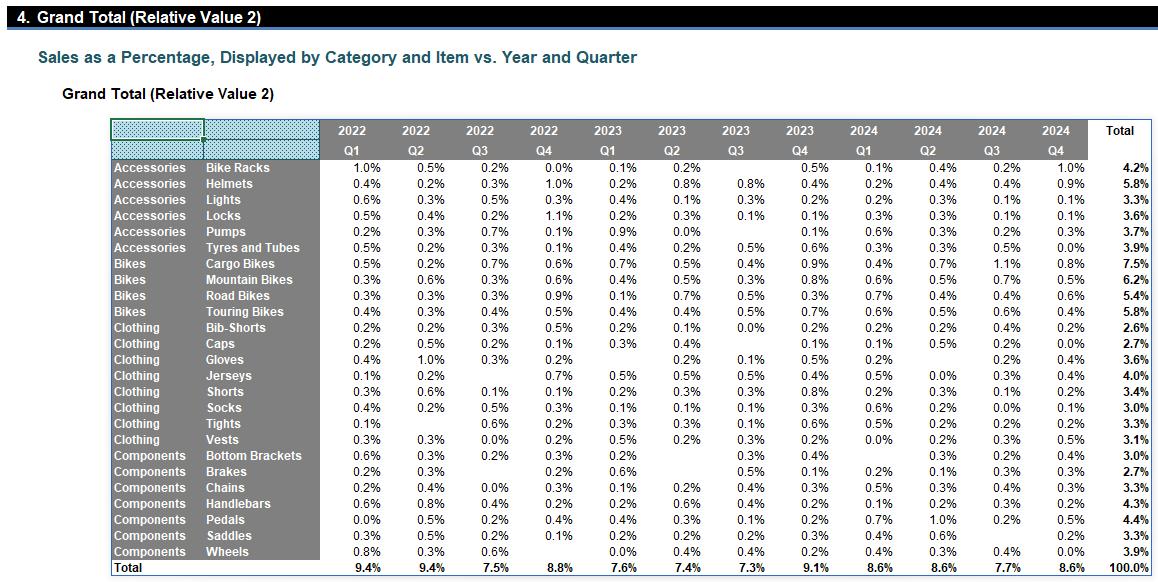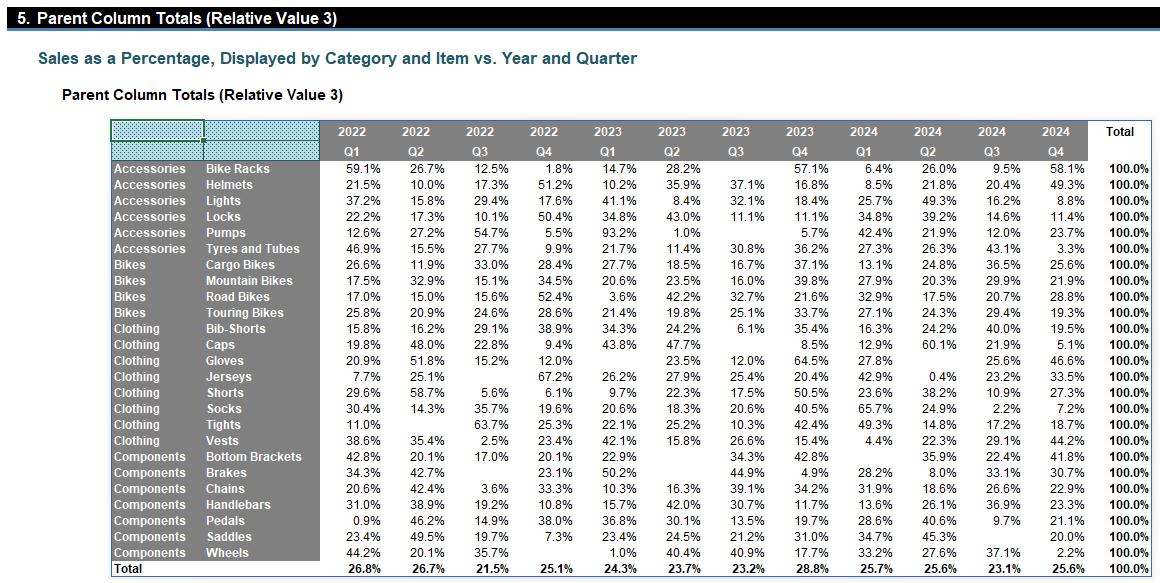Revision to PIVOTBY
16 May 2024
Back in November last year, Microsoft announced several new functions, including PIVOTBY, and eta lambdas such as PERCENTOF. On the quiet, they have added a new argument which makes PIVOTBY just that little bit more powerful.
At the time of writing, they are rolling out to users enrolled in the beta channel for Windows Excel and Mac Excel. Don’t be upset if you don’t get this new update straight away. But first, let’s have a little refresher…
eta Lambdas
These “eta reduced lambda” functions may sound scary, but they make the world of dynamic arrays more accessible to the inexperienced. They help make the other three functions simpler to use. Dynamic array calculations using basic aggregation functions often require syntax such as
LAMBDA(x, SUM(x))
LAMBDA(y, AVERAGE(y))
etc.
However, given x and y (above) are merely dummy variables, an “eta lambda” function simply replaces the need for this structure with the so-easy-anyone-can-understand-it syntax of
SUM
AVERAGE
etc.
Even I can do it. For example, consider the following formula in cell G17 below:

=BYCOL(G13:J16,LAMBDA(x,SUM(x)))
This sums the range G13:J16 by column using that LAMBDA(x, SUM(x)) trick. But there is no need for this anymore, viz.

=BYCOL(G21:J24,SUM)
That’s much simpler and many one argument functions may now be turned into eta lambdas (and one or two other functions too).
PERCENTOF
This function can be used in conjunction with PIVOTBY (below) or on its own. This is used to return the percentage that a subset makes up of a given dataset. It is logically equivalent to
SUM(subset) / SUM(everything)
It sums the values in the subset of the dataset and divides it by the sum of all the values. It has the following syntax:
=PERCENTOF(data_subset, data_all)
The arguments are as follows;
- data_subset: this is required, and represents the values that are in the data subset
- data_all: this too is required and denotes the values that make up the entire set.
You can use it, for example, with GROUPBY:
=GROUPBY(tbl[Category],tbl[Sales],PERCENTOF)

Alternatively, it may be used on its own:

PIVOTBY
The reason for this article is that PIVOTBY has changed. It has added a new, final argument: relative_to – but let’s back up first.
The PIVOTBY function allows you to create a summary of your data via a formula too, akin to a formulaic PivotTable. It supports grouping along two axes and aggregating the associated values. For instance, if you had a table of sales data, you might generate a summary of sales by state and year.
It should be noted that PIVOTBY is a function that returns an array of values that can spill to the grid. Furthermore, at this stage, not all features of a PivotTable appear to be replicable by this function.
The syntax of the PIVOTBY function is:
PIVOTBY(row_fields, col_fields, values, function, [field_headers], [row_total_depth], [row_sort_order], [col_total_depth], [col_sort_order], [filter_array], [relative_to])
It has the following arguments:
- row_fields: this is required, and represents a column-oriented array or range that contains the values which are used to group rows and generate row headers. The array or range may contain multiple columns. If so, the output will have multiple row group levels
- col_fields: also required, and represents a column-oriented array or range that contains the values which are used to group columns and generate column headers. The array or range may contain multiple columns. If so, the output will have multiple column group levels
- values: this is also required, and denotes a column-oriented array or range of the data to aggregate. The array or range may contain multiple columns. If so, the output will have multiple aggregations
- function: also required, this is an explicit or eta reduced lambda (e.g. SUM, PERCENTOF, AVERAGE,COUNT) that is used to aggregate values. A vector of lambdas may be provided. If so, the output will have multiple aggregations. The orientation of the vector will determine whether they are laid out row- or column-wise
- field_headers: this and the remaining arguments are all optional. This represents a number that specifies whether the row_fields, col_fields and values have headers and whether field headers should be returned in the results. The possible values are:
- Missing: Automatic
- 0: No
- 1: Yes and don't show
- 2: No but generate
- 3: Yes and show
It should be noted that “Automatic” assumes the data contains headers based upon the values argument. If the first value is text and the second value is a number, then the data is assumed to have headers. Fields headers are shown if there are multiple row or column group levels
- row_total_depth: this optional argument determines whether the row headers should contain totals. The possible values are:
- Missing: Automatic, with grand totals and, where possible, subtotals
- 0: No Totals
- 1: Grand Totals
- 2: Grand and Subtotals
- -1: Grand Totals at Top
- -2: Grand and Subtotals at Top
It should be noted that for subtotals, row_fields must have at least two [2] columns. Numbers greater than two [2] are supported provided row_field has sufficient columns
- row_sort_order: again optional, this
argument denotes a number indicating how rows should be sorted. Numbers correspond with the columns in row_fields followed by the columns in values.
If the number is negative, the rows are sorted in descending / reverse
order. A vector of numbers may be
provided when sorting based upon only row_fields
- col_total_depth: this optional argument determines whether the column headers should contain totals. The possible values are:
- Missing: Automatic, with grand totals and, where possible, subtotals
- 0: No Totals
- 1: Grand Totals
- 2: Grand and Subtotals
- -1: Grand Totals at Top
- -2: Grand and Subtotals at Top
It should be noted that for subtotals, col_fields must have at least two [2] columns. Numbers greater than two [2] are supported provided col_field has sufficient columns
- col_sort_order: again optional, this
argument denotes a number indicating how they should be sorted. Numbers correspond with the columns in col_fields followed by the columns in values.
If the number is negative, these are sorted in descending / reverse
order. A vector of numbers may be
provided when sorting based upon only col_fields
- filter_array: this is now the penultimate optional argument, it represents a column-oriented one-dimensional array of Boolean values [1, 0]
that indicate whether the corresponding row of data should be considered. It should be noted that the length of the
array must match the length of row_fields and col_fields
- relative_to: this new, final argument
allows you to summarise functions relative to row and column totals or the
grand total. Five alternatives are
possible:
- 0: Column Totals (default) (Screentip: Calculation performed relative to all values in column)
- 1: Row Totals (Calculation performed relative to all values in row)
- 2: Grand Total (Calculation performed relative to all values)
- 3: Parent Column Total (Calculation performed relative to all values in column parent)
- 4: Parent Row Total (Calculation performed relative to all values in row parent).
Let’s look at PIVOTBY using PERCENTOF, highlighting this new relative_to final argument. You can follow along with the attached Excel file.
Consider the following Table (CTRL + T) called Data (truncated):

Here, we have two parent / child relationships:
- Year and Quarter
- Category and Item.
From our previous article on PIVOTBY, we can create a formulaic alternative to a PivotTable (with crafty formatting) using the following formula:
=PIVOTBY(Data[[Category]:[Item]],Data[[Year]:[Quarter]],Data[Sales],PERCENTOF)

Note that each column of sales is represented as a percentage of that column (including the Total column). Whilst it was a great start, Microsoft received feedback that end users wanted to see percentages summarised in alternative ways – and that is what has been addressed here.
This newly introduced final argument, relative_to, behaves the same in scenario 0: Column Totals. This is the default view:
=PIVOTBY(Data[[Category]:[Item]],Data[[Year]:[Quarter]],Data[Sales],PERCENTOF,,,,,,,0)

It is clear to see this is identical to the first output. But let’s see what happens when we start playing with the final argument. Let’s change this value to 1: Row Totals.
=PIVOTBY(Data[[Category]:[Item]],Data[[Year]:[Quarter]],Data[Sales],PERCENTOF,,,,,,,1)
Now, each row of sales is represented as a percentage of that row (including the Total row), viz.

If you wish, you can show the sales as a percentage of the Grand Total, using 2: Grand Total:
=PIVOTBY(Data[[Category]:[Item]],Data[[Year]:[Quarter]],Data[Sales],PERCENTOF,,,,,,,2)

There are still two further scenarios – and this is why our example contained two parent / child relationships. The first is 3: Parent Column Total:
=PIVOTBY(Data[[Category]:[Item]],Data[[Year]:[Quarter]],Data[Sales],PERCENTOF,,,,,,,3)

Here, the Total column is 100% throughout. It is a little confusing as, if anything, it looks a little like Scenario 1: Row Totals. This is because the column here refers to the headings in each column, i.e. Year and Quarter. You can see that for any row the sum of the four quarters for any given year totals 100% (including the Total row).
Finally, Scenario 4: Parent Row Total considers the other parent / child relationship:
=PIVOTBY(Data[[Category]:[Item]],Data[[Year]:[Quarter]],Data[Sales],PERCENTOF,,,,,,,4)

In this final illustration, the Total row is 100% throughout. This looks similar to the default Scenario 0: Column Totals. This is because the row here refers to the headings in each row, i.e. Category and Item. You can see that for any row the sum of any category for any given Quarter and Year totals 100% (including the Total column).
Word to the Wise
Starting with RANDARRAY, Microsoft continues to venture into new territory by tinkering with new functions and features whilst they remain in beta. Previously, revising a function’s signature / syntax was unheard of. Here at SumProduct, we’re not complaining. The software giant has been collating formula usage and explicit feedback to determine what is missing / needs revising – and then done something about it.
If only they had done that with MATCH many years ago!!

